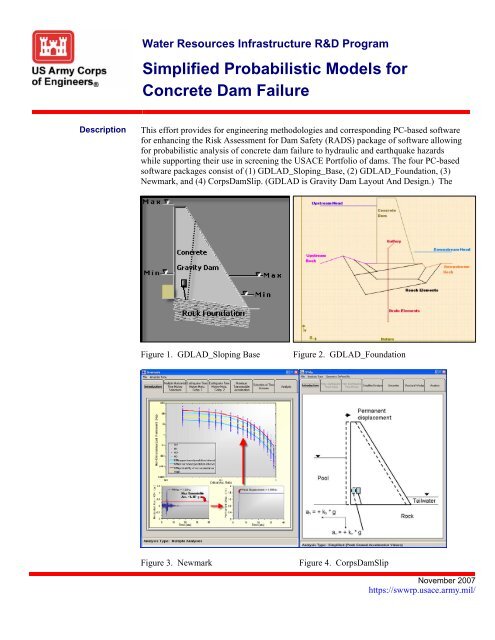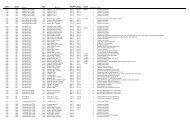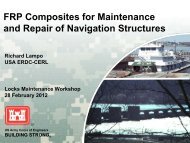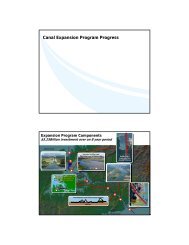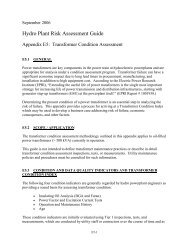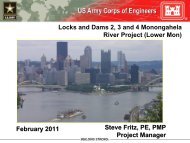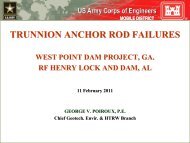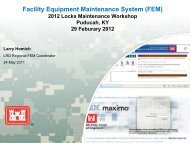Simplified Probabilistic Models for Concrete Dam Failure - U.S. Army
Simplified Probabilistic Models for Concrete Dam Failure - U.S. Army
Simplified Probabilistic Models for Concrete Dam Failure - U.S. Army
Create successful ePaper yourself
Turn your PDF publications into a flip-book with our unique Google optimized e-Paper software.
Water Resources Infrastructure R&D Program<strong>Simplified</strong> <strong>Probabilistic</strong> <strong>Models</strong> <strong>for</strong><strong>Concrete</strong> <strong>Dam</strong> <strong>Failure</strong>DescriptionThis ef<strong>for</strong>t provides <strong>for</strong> engineering methodologies and corresponding PC-based software<strong>for</strong> enhancing the Risk Assessment <strong>for</strong> <strong>Dam</strong> Safety (RADS) package of software allowing<strong>for</strong> probabilistic analysis of concrete dam failure to hydraulic and earthquake hazardswhile supporting their use in screening the USACE Portfolio of dams. The four PC-basedsoftware packages consist of (1) GDLAD_Sloping_Base, (2) GDLAD_Foundation, (3)Newmark, and (4) Corps<strong>Dam</strong>Slip. (GDLAD is Gravity <strong>Dam</strong> Layout And Design.) TheFigure 1. GDLAD_Sloping BaseFigure 2. GDLAD_FoundationFigure 3. NewmarkFigure 4. Corps<strong>Dam</strong>SlipNovember 2007https://swwrp.usace.army.mil/
first two are used to construct fragility curves <strong>for</strong> concrete gravity dams founded on orfounded in rock with the probability of dam failure expressed in terms of fragility curves.GDLAD_Foundation allows <strong>for</strong> the analysis of the uncertainty in uplift pressures via theanalysis of seepage within rock joints (unique software). Newmark and Corps<strong>Dam</strong>Slipaddress the seismic hazard in terms of permanent displacements; a critical item withregards to maintaining a functional foundation drains system and uplift pressure reliefduring and after an earthquake. Specifically, Newmark is used to develop simplifiedpermanent de<strong>for</strong>mation analysis relationships <strong>for</strong> rock-founded structures using regressionbased methods of analysis that result in permanent de<strong>for</strong>mation relationships that needonly values <strong>for</strong> peak acceleration and peak velocity on rock. The resulting Newmarksimplified permanent de<strong>for</strong>mation relationships are then implemented in Corps<strong>Dam</strong>Slipand used <strong>for</strong> the seismic permanent de<strong>for</strong>mation analysis of a site-specific concrete gravitydam. Corps<strong>Dam</strong>Slip, is also used to construct fragility curves <strong>for</strong> use in Portfolio RiskAssessments. All four PC-based programs have a user friendly graphical user interface(GUI) <strong>for</strong> both input and viewing computed results.BenefitsStatusDistribution Source(s)AvailableDocumentationAvailable TrainingAvailable SupportApplicationPoint of ContactPartnersGDLAD_Sloping_Base, GDLAD_Foundation rapidlyproduce system response curves (i.e., fragility curves)<strong>for</strong> hydraulic hazards <strong>for</strong> use by Districts in theirPortfolio Risk Assessments to prioritize the limitedfunds available <strong>for</strong> Corps projects and justify economicdam safety investments to reduce the overall publicrisk from the Corps’ inventory of dams. WithoutNewmark and Corps<strong>Dam</strong>Slip, the Corps has no methodto compute the permanent seismically induceddisplacement of a rock-founded concrete gravity damdue to earthquake hazards.District requested changes were implemented in GDLAD_Sloping_Base and it wascompleted in FY08, its user’s guide is in publication. Newmark has the same status. Thefocus in FY09 is on the <strong>for</strong>mulation and programming of GDLAD_Foundation. An initialfunctional version of Corps<strong>Dam</strong>Slip was developed in FY08 and the implementation of thefragility curve procedure of analysis is yet to be done.This software will be distributed through the CASE web site and will also be madeavailable via the RADS portal and will also be located on a Corps server with accesscontrolled by the Risk and Reliability DX.GDLAD_Sloping_Base and Newmark user’s guides and examples are available in ERDCTechnical Reports. Corps_<strong>Dam</strong>_Slip and GDLAD_Foundation user’s guides areincomplete and in partial draft <strong>for</strong>ms.Training will be made available though RADS training classes <strong>for</strong> the National Teams.Application support can be obtained by contacting Dr. Robert Ebeling at ERDC-ITL.The <strong>Dam</strong> Safety Methodology Team as well as all District engineers will be able to use thePC-based software.Dr. Robert Ebeling, In<strong>for</strong>mation Technology Laboratory, US <strong>Army</strong> Engineer Research andDevelopment Center, 3909 Halls Ferry Road, Vicksburg, MS 39180 E-mail:Robert.M.Ebeling@usace.army.milDr. Robert Ebeling and Ms.Moira Fong of ERDC-ITL and Dr. Johannes Wibowo and Mr.Don Yule of ERDC-GSL.


